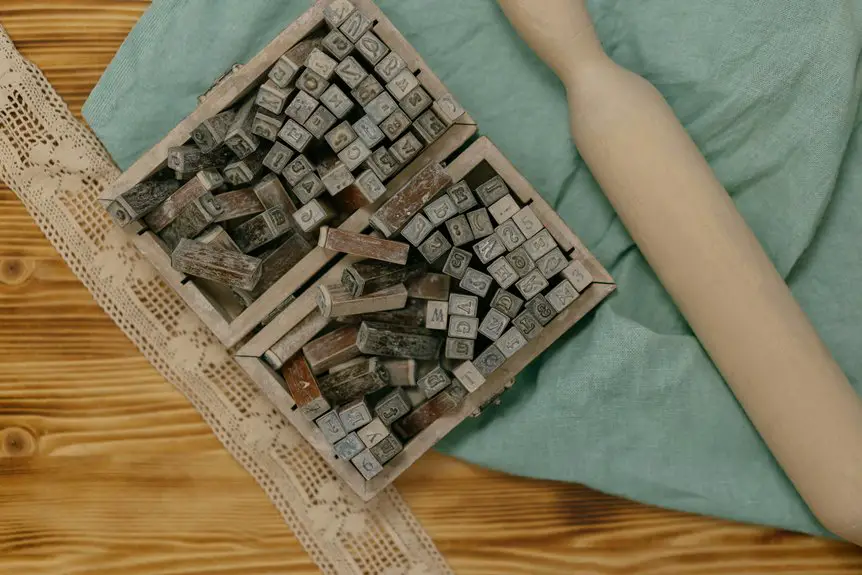To print successfully on an 85% polyester and 15% polyamide blend, you’ll want to use sublimation inks designed for polyester blends and set your heat press between 380°F and 400°F with medium pressure for about 45 seconds. Pre-treat and dry the fabric to guarantee vibrant, lasting colors, and prepare your design in RGB at 300 DPI for sharp details. Following these steps helps you avoid common issues and get great results—there’s plenty more to master for flawless prints on this fabric mix.
Table of Contents
Key Takeaways
- Use a sublimation printer compatible with polyester blends and inks designed for synthetic fibers to ensure vibrant, durable prints on the 85% polyester fabric.
- Pre-treat fabric with a specialized solution and pre-press to remove moisture and wrinkles, enhancing ink absorption and print sharpness.
- Set heat press temperature between 380°F and 400°F for 40-50 seconds using medium pressure to optimize ink bonding without damaging polyamide fibers.
- Design files should be in RGB color profile with at least 300 DPI resolution to maintain bright, crisp sublimation prints on the blend fabric.
- After printing, wash garments in cold water inside out with mild detergent and air dry or tumble dry low to preserve print quality and fabric integrity.
Understanding the Fabric Blend: Polyester and Polyamide
When you work with polyester and polyamide blends, it’s important to understand their unique properties.
Polyester offers durability, wrinkle resistance, and excellent color retention. Polyamide, or nylon, adds softness, elasticity, and moisture-wicking capabilities. Together, they create a fabric that balances strength with comfort.
Polyester provides durability and color retention, while polyamide adds softness and moisture-wicking for balanced strength and comfort.
You’ll notice polyester’s smooth surface helps maintain print clarity, while polyamide’s stretchiness allows better fit and movement.
However, polyamide can be more sensitive to heat and chemicals than polyester, so you’ll need to handle the blend carefully to avoid damaging the fibers.
This mix is popular in activewear and outdoor gear because it combines resilience with comfort.
Knowing these traits helps you anticipate how the fabric behaves during production and wear, ensuring you achieve the best results with your projects.
How Sublimation Ink Interacts With 85% Polyester 15% Polyamide
Understanding the properties of an 85% polyester and 15% polyamide blend helps you predict how sublimation ink will bond with the fabric. Since sublimation ink bonds best with polyester fibers, the high polyester content guarantees strong ink absorption and vibrant color retention.
The polyamide portion, however, doesn’t bond with sublimation ink as effectively. This means you might notice slightly less saturation or unevenness in some areas. Still, the polyester dominance allows the design to transfer well, maintaining durability and washability.
When you apply heat and pressure during sublimation, the ink converts to gas and embeds itself into the polyester fibers, resulting in a permanent, vivid print. Keep in mind, the polyamide fibers remain largely uncolored, which can subtly affect the overall print uniformity.
Preparing Your Design for Optimal Color Vibrancy
To get the brightest colors on polyester and polyamide, you’ll want to start by choosing the right color profile for your design.
Make sure your image resolution is high enough to avoid pixelation during printing.
Also, boosting contrast in your design helps colors pop and keeps details sharp after sublimation.
Color Profile Selection
Although selecting the right color profile might seem technical, it directly impacts how vibrant and true your sublimated design appears on polyester and polyamide fabrics.
You want to work with color profiles tailored for sublimation printing, like Adobe RGB or sRGB, which offer a wide color gamut that your printer can accurately reproduce.
Avoid using CMYK profiles since sublimation printers use RGB inks, and mismatched profiles can dull your colors.
Before printing, convert your design to the chosen RGB profile to guarantee color consistency.
Also, calibrate your monitor to match the printer’s output as closely as possible.
This way, what you see on-screen aligns with the final print, letting your colors pop and your designs shine on the fabric.
Image Resolution Importance
Getting your color profiles right sets a solid foundation, but the sharpness and clarity of your design heavily depend on image resolution.
When preparing your artwork, use a resolution of at least 300 DPI at the final print size to guarantee crisp details. Lower resolutions can cause blurry or pixelated prints, diminishing the vibrancy and professionalism of your sublimated fabric.
Always work with high-quality source images and avoid scaling up smaller files, as this leads to loss of detail. Additionally, save your designs in formats that preserve quality, like TIFF or PNG.
Design Contrast Enhancement
When you enhance the contrast in your design, you make colors appear more vibrant and details more defined on polyester and polyamide fabrics.
Start by adjusting brightness and contrast levels in your design software to deepen shadows and brighten highlights. Use complementary colors to create striking visual differences that pop during sublimation.
Avoid overly subtle gradients that can lose definition once printed. Sharpen edges and fine details to retain clarity on the fabric’s texture.
Keep in mind that the fabric’s blend may slightly mute colors, so boosting contrast compensates for this effect. Test print small swatches to see how your adjustments translate.
Choosing the Right Sublimation Printer and Ink
How do you guarantee vibrant, lasting prints on polyester and polyamide fabrics? Start by choosing a sublimation printer and ink designed for synthetic blends. Not all printers handle polyester-polyamide mixes well, so pick ones with consistent heat and ink control. Look for inks labeled for polyester blends to guarantee strong color bonding.
| Printer Model | Ink Type | Best For |
|---|---|---|
| Epson SureColor | Sublimation Ink | High-detail graphics |
| Sawgrass Virtuoso | Polymer Ink | Vivid color reproduction |
| Ricoh SG 7100 | Eco-Solvent Ink | Durability on blends |
| Epson F170 | Dye-Sublimation | Entry-level projects |
| Mutoh ValueJet | Sublimation Ink | Large format printing |
Choosing the right combo sets your prints up for success.
Setting the Ideal Temperature and Pressure for the Blend
You’ll want to set the right temperature and pressure to get the best results on polyester and polyamide blends.
Understanding the ideal heat settings and pressure levels helps guarantee the dye properly transfers without damaging the fabric.
Also, timing plays an essential role, so you’ll need to balance all three for a perfect print.
Optimal Heat Settings
Achieving the perfect heat settings is essential for successful sublimation on polyester and polyamide blends. You need to balance temperature carefully to guarantee vibrant colors without damaging the fabric.
For an 85% polyester and 15% polyamide mix, aim for a temperature range that activates the polyester’s dye sites without overheating the polyamide.
Keep these tips in mind:
- Set your heat press between 380°F and 400°F (193°C-204°C)
- Limit heat exposure to 40-50 seconds
- Use a heat-resistant tape to avoid shifting during pressing
- Pre-press your fabric to remove moisture and wrinkles
- Always test on a small fabric area before full production
Fine-tuning these settings helps you achieve sharp, lasting prints every time.
Pressure Levels Explained
Three key pressure levels can make or break your sublimation results on polyester and polyamide blends.
Low pressure won’t transfer the ink properly, leaving your print faded or spotty. High pressure, on the other hand, risks crushing the fabric’s texture and causing color bleeding.
You want to aim for medium pressure—firm enough to guarantee the ink bonds well but gentle enough to preserve the material’s integrity. Adjust your heat press so that when you close it, you feel resistance but still can slightly move the platen.
This balance helps the sublimation dye penetrate evenly without damaging the delicate polyamide fibers mixed with polyester. Remember, consistent pressure throughout the press time is just as important as setting it correctly from the start.
Time Considerations
Finding the right balance between time, temperature, and pressure is essential for successful sublimation on polyester and polyamide blends.
When working with an 85% polyester and 15% polyamide fabric, adjusting your time settings carefully guarantees vibrant color transfer without damaging the material. Too short, and the design won’t fully transfer; too long, and you risk scorching or fabric distortion.
Keep these timing tips in mind:
- Start with 35-45 seconds as a baseline
- Adjust in 5-second increments based on results
- Use moderate temperature around 190-200°C (374-392°F)
- Apply medium pressure to avoid imprint marks
- Always test on a scrap piece before full runs
Pre-Treatment Techniques to Enhance Ink Absorption
When you want vibrant, long-lasting prints on polyester and polyamide, pre-treatment plays a crucial role in improving ink absorption.
Start by cleaning the fabric thoroughly to remove oils or residues that hinder ink bonding. Next, apply a specialized pre-treatment solution designed for polyester blends; this creates a receptive surface for sublimation inks.
You can use a spray or dip method, ensuring even coverage without saturating the fabric. After application, let the fabric dry completely, either at room temperature or with gentle heat.
This step enhances the fabric’s ability to hold dye, resulting in sharper, more vivid images. Remember, skipping or rushing pre-treatment can lead to faded prints and poor durability, so take your time to prepare the fabric properly before sublimation.
Step-by-Step Sublimation Printing Process on the Blend
Begin the sublimation printing process by ensuring your pre-treated polyester and polyamide blend is completely dry and wrinkle-free.
Start sublimation printing with a dry, wrinkle-free pre-treated polyester and polyamide fabric.
Next, set your heat press to 400°F (204°C) and a medium pressure setting. Place your printed sublimation paper face-down on the fabric, then cover it with a protective sheet to prevent ink transfer issues.
Follow these steps for best results:
- Preheat the fabric to remove moisture
- Position the sublimation transfer paper accurately
- Apply heat and pressure for 45–60 seconds
- Remove the paper carefully while hot
- Allow the fabric to cool before handling
Common Challenges and How to Overcome Them
Following the step-by-step sublimation process helps achieve vibrant prints, but you might still encounter some challenges along the way. Common issues include uneven color, fabric damage, or weak adhesion. Knowing how to tackle these problems saves you time and material. Here’s a quick guide:
| Challenge | Cause | Solution |
|---|---|---|
| Faded Colors | Low temperature or time | Increase heat or press duration |
| Blurry Images | Poor transfer paper alignment | Use registration marks |
| Fabric Damage | Excessive heat or pressure | Adjust temperature and pressure |
| Weak Adhesion | Low polyester content | Use heat press with higher PSI |
Addressing these will help you get consistent, high-quality prints on your 85% polyester 15% polyamide fabric.
Post-Printing Care to Preserve Color and Fabric Integrity
Although the sublimation process sets your design, proper post-printing care guarantees the colors stay vivid and the fabric remains strong.
To keep your 85% polyester and 15% polyamide prints looking fresh, follow these key steps:
- Wash in cold water to prevent color fading and fabric damage.
- Use mild detergents; avoid bleach or harsh chemicals.
- Turn garments inside out before washing to protect the print.
- Air dry or tumble dry on low heat to maintain fabric integrity.
- Avoid ironing directly on the printed area; use a cloth if needed.
Tips for Consistent Results With Mixed Fabric Sublimation
To get consistent results with mixed fabric sublimation, you’ll need to focus on proper fabric preparation, precise temperature and time settings, and matching your ink with the right printer.
Each factor plays a vital role in ensuring vibrant, durable prints.
Let’s explore how to optimize these elements for the best outcome.
Fabric Preparation Techniques
Achieving consistent sublimation results on mixed fabrics like polyester and polyamide starts with proper fabric preparation.
Before you begin, make certain to prep your fabric carefully to guarantee vibrant, lasting prints. Here’s what you should do:
- Wash the fabric without fabric softeners to remove oils and residues.
- Iron the fabric to eliminate wrinkles that can distort the print.
- Pre-press the fabric for a few seconds to remove moisture and flatten the surface.
- Use a lint roller to clear any dust or fibers that might interfere with ink transfer.
- Avoid stretching the fabric during preparation to maintain its shape and print accuracy.
These steps help create an ideal surface for sublimation inks, improving adhesion and color vibrancy on your 85% polyester, 15% polyamide blend.
Temperature and Time Settings
Proper fabric preparation sets the stage, but mastering the right temperature and time settings is what guarantees your sublimation prints on polyester and polyamide come out vibrant and durable.
For an 85% polyester and 15% polyamide blend, aim for a temperature around 380°F (193°C). This balance guarantees the polyester fibers absorb the dye without damaging the more delicate polyamide.
Keep your pressing time between 45 to 60 seconds to avoid overheating, which can cause color dullness or fabric distortion. Use consistent pressure throughout the process to promote even dye transfer.
If you notice any fading or uneven colors, slightly adjust your temperature or time in small increments. By fine-tuning these settings, you’ll achieve crisp, long-lasting prints every time on your mixed fabric projects.
Ink and Printer Compatibility
Ink quality and printer compatibility play an essential role in ensuring your sublimation prints on polyester and polyamide blends come out sharp and vibrant.
You want to use inks specifically designed for sublimation to achieve lasting, bright results. Not all printers handle sublimation inks equally, so choosing the right one is vital.
Here’s what you should focus on:
- Use dye-sublimation inks compatible with your printer model
- Opt for printers that support high-resolution printing
- Avoid generic inks that may clog nozzles or fade quickly
- Check for printers with consistent heat management
- Test print on small fabric swatches before full runs
Frequently Asked Questions
Can Sublimation Be Done on 100% Polyamide Garments?
You can’t effectively sublimate on 100% polyamide because it lacks enough polyester content to hold the dye. You’ll need at least 50% polyester for vibrant, lasting prints. Consider blending or alternative printing methods instead.
How Does Humidity Affect Sublimation on Polyester Blends?
Did you know 60% humidity optimizes sublimation? When printing on polyester blends, high humidity can cause ink bleeding, while low humidity may lead to dull colors. You should maintain balanced humidity for vibrant, sharp prints every time.
Are There Eco-Friendly Sublimation Inks Suitable for This Fabric?
You can use eco-friendly sublimation inks made from water-based, non-toxic materials that work well on polyester blends. These inks reduce environmental impact while maintaining vibrant colors and durability on your fabric.
Can Sublimation Printing Be Combined With Other Printing Methods?
You can combine sublimation with other printing methods like screen printing or direct-to-garment. Just guarantee each layer’s compatible and cured properly to avoid issues. This mix enhances designs, offering vibrant, durable results on various fabrics.
What Are the Best Washing Detergents for Sublimated Polyester/Polyamide?
Think of your detergent as a gentle rain nurturing delicate flowers. You’ll want to use mild, color-safe detergents without bleach or fabric softeners to keep your sublimated polyester/polyamide vibrant and lasting through every wash.
- The Use of Nonwovens in Construction and Civil Engineering - July 11, 2025
- The Use of Nonwovens in Construction and Civil Engineering - July 11, 2025
- The Use of Nonwovens in Construction and Civil Engineering - July 11, 2025







